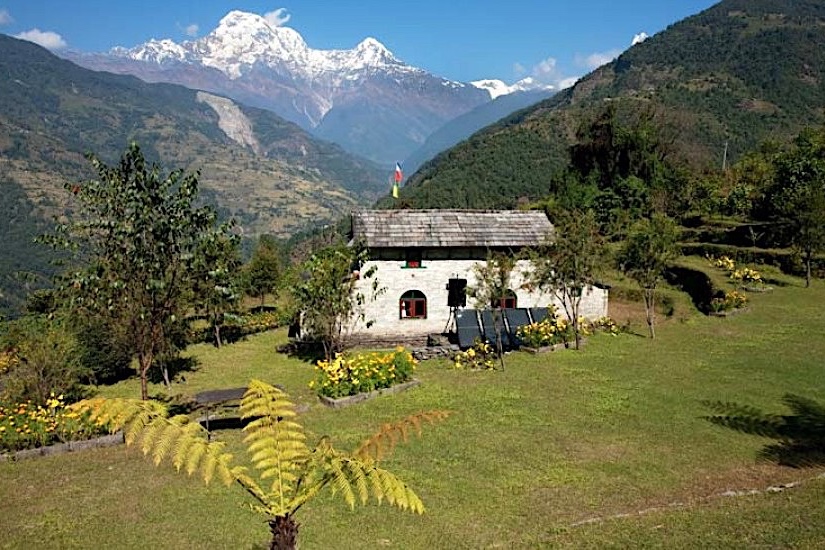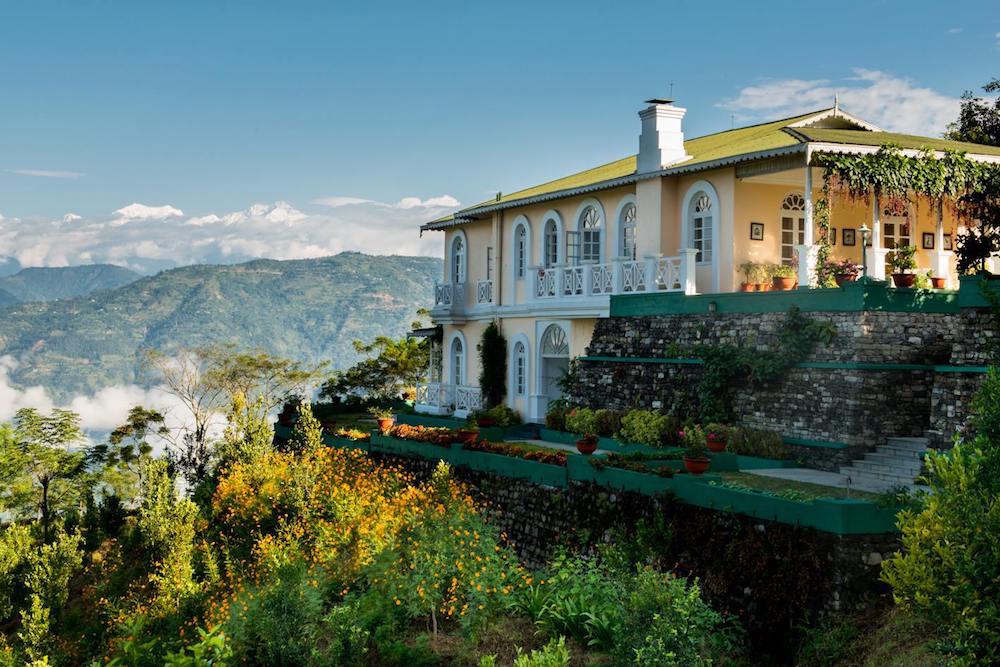Nepal possesses 8 of the 10 highest mountains in the world which we can navigate with experienced guides and sherpas, whilst staying in remote mountain lodges or under canvas. Witness Everest and the Annapurna range from dizzying heights by helicopter, microlight or plane and we have some unique safari experiences at our fingertips, as well.
-
Since the infamous earthquake of 2015, Nepal has bounced back to its former self and affords any adventurer worth their salt an exciting, exhilarating travel experience. It’s the Himalayas that are perhaps the main draw here: jagged, awe-inspiring ranges with snow-covered summits, rising up to the highest point in the world. But look further, and you’ll discover a rich culture, fascinating history and extreme contrasts between the epic, soaring peaks and the tiny villages nestled below them. Nepal offers spiritual encounters aplenty with towns full of temples, incense and fluttering prayer flags. There’s also astonishing wildlife to discover across the country’s differing climatic conditions: Bengal tigers, one-horned black rhino and elephants roam jungles teeming with birdlife.
We suggest dividing your time between chaotic but colourful Kathmandu, serene Pokhara, whose lake reflects the snow-capped mountains, and Chitwan, where the national park provides exhilarating wildlife encounters. Of course, there are endless alternatives and we specialise in matching you with those remote, secret parts of the country that you might never have considered.
Wix Squared has some exceptional guides to get you under the skin of the country including:
- Trekking and mountaineering professionals
- Wildlife and safari guides who know Nepal’s national parks like the backs of their hands
- Authorities on the Hindu and Buddhist religions
- Yoga and meditation gurus
- Mountain biking guides
- Culinary maestros
- Top level motorbiking and fishing guides
-
Itinerary Starting Price
From £2,500 per person, for 7 days including accommodation, private guiding and private transfers (not including flights).
Random Fact
Nepal is the world’s only country not to have a rectangular shaped flag.
Festival
The Hindu harvest festival, Dashain, takes place over 15 days between September – October. It celebrates the goddess Durga and the victory of good over evil. It’s a time for family reunions, elaborate pujas, flying kites and sword processions.
What to Eat
Nepal’s unofficial national dish is the ubiquitous Dal Bhat. It’s a staple for locals and travellers too, served at most guest houses on trekking routes. Quite simply, it’s lentils and rice – filling and nutritious.
What to Read
On a journey that’s as much spiritual as it is physical, Peter Matthiessen’s The Snow Leopard recounts his adventure into Nepal’s remote Upper Dolpo region, on a quest to find the elusive snow leopard.
What to buy
Unique handicrafts you won’t find anywhere else. Whether it’s an intricately painted thangka or a deftly carved wooden mask, Nepal’s arts and craft scene is a wonderful reflection of its rich culture.
-

Kathmandu
There are a decent handful of characterful but comfortable hotels amongst the busy streets of Nepal’s capital. Baber Mahal Villas is a simple, family-run boutique option with its own rooftop pool whereas the Hyatt is larger and more international with exceptional views of Boudhanath Stupa. Dwarika’s – our favourite – perhaps best captures the spirit of Kathmandu and it has a sister property, Dwarikas Resort Dhulikel, an alpine retreat an hour’s drive outside the city.

Pokhara & Mustang
1000 metres up in the hills above Pokhara, with soaring views over the valley, sits Tiger Mountain Pokhara Lodge. You’ll be looked after by an excellent host and treated to delicious, freshly cooked meals. A little closer to the action is The Pavilions, an eco-conscious retreat, perfectly placed for a range of adventurous activities such as trekking, rafting and paragliding. From Pokhara, journey north to Lower Mustang and get completely off the beaten track in this lush terrain, heavily influenced by Tibetan culture, whilst staying in the luxury of Shinta Mani Mustang – A Bensley Collection.

On the move
Dotted along the rugged trails that lead to Everest and beyond are a collection of surprisingly luxurious accommodation options. Offering comfort in the form of hot showers, good beds and great food, the Ker and Downey Lodges are the stuff of dreams for weary trekkers. The Happy House, one-time favourite of Sir Edmund Hillary himself, is now a Himalayan haven run by the Sherpa family who built it. Elsewhere, you’ll be hard pressed to find better views to awake to than those offered by Yeti Mountain Lodges or those accessed from private mobile camps.

Safari lodges
Renowned pioneers in wildlife conservation and responsible tourism, Tiger Tops offers premium safari experiences fused with local cultural encounters from their two charmingly rustic lodges in Chitwan and Bardia National Parks. Chitwan is also home to the rustic Barahi Jungle Lodge which is great for families and the more opulent Taj Meghauli Serai, situated on the banks of the Rapti River and designed in the style of local tribal homes with the addition of plunge pools. All options offer immersive, rigorously ethical, elephant experiences.
-

Kathmandu
Gateway to the Himalayas, Kathmandu is a city of chaotic and colourful beauty. The unassuming, labyrinthine alleyways of Thamel lead to more UNESCO World Heritage sites than you can count, religious sites of epic proportions such as Boudhanath’s bulging white stupa and the peaceful, serene Garden of Dreams. We can introduce you to the world’s only Living Goddess, teach you the intricate art of thangka painting or take you cycling through hidden corners of the city.

Sacred sites
Temples, monasteries and stupas are omnipresent across the country, as are the sounds of soft chanting and fluttering prayer flags. Join the crowds circumambulating Boudanath’s stupa, visit the Buddha’s birthplace at Lumbini or witness the mesmerising cremation rituals at Pashupatinath on the banks of the Bagmati River. Several of our guides are monks themselves and can shine a light on the significance of everything from the lighting of butter lamps to the art of meditation.

Wildlife
The exotic jungles of southern Nepal offer some of the best wildlife encounters in Asia. Easily accessible – only 20 minutes by plane from Kathmandu – lies Chitwan, Nepal’s most popular National Park, while Bardia National Park is more remote and pristine. Both offer the chance to spot monkeys, leopards, rhino, elephant, gharial crocodile and the majestic Royal Bengal Tiger. Our connections enable us to arrange specialist tiger and snow leopard conservation experiences too.

Action-packed adventure
Nepal’s high-octane trekking is exhilarating and challenging with something for every ability. You’re in safe hands with our guides and sherpas but if you don’t fancy going on foot, why not let us organise a helicopter flight up to Everest, complete with a champagne breakfast at 13,000ft? Nepal’s dramatic geography also offers the chance to mountain bike, bungee jump, zip-wire and paraglide while at lower altitudes there are glacial lakes to canoe across and canyoning too.

Cuisine
Despite Nepal’s proximity to its neighbour, Nepalese cuisine is quite distinct to India’s. Alongside the ubiquitous dhal baat come dishes rich in flavour with ingredients such as fenugreek, mustard oil, ginger and cinnamon, not to mention some of the best dumplings outside China, known locally as momos. We’ll take you inside a private home or behind the scenes of a local restaurant to experience the country’s warm hospitality and culinary secrets.

Pokhara
The jump off point for most Himalayan treks, mountain lovers head straight to Pokhara, as do adrenaline junkies, who come for the world-class paragliding, white water rafting and mountain biking. It’s also, however, a great place to recharge your batteries. Significantly more relaxed than the capital, Pokhara town itself stretches out along the serene shores of Lake Phewa, which reflects the awesome Machapuchare, otherwise known as Fishtail Mountain.
-
Sharing many similarities in terms of climate, elevation and landscape, you’ll discover colourful contrasts in the religions, cultures and traditions of these two intriguing Himalayan nations. Both relatively untouched by the passage of time, they’re just over an hour from each other by plane.
After a week or so trekking in the Himalayas, why not head south to unadulterated relaxation on Thailand’s azure shores? A short flight takes you directly from Kathmandu to Bangkok from where you can drive or take a connecting flight to numerous exclusive beach hideaways.
With the border only a matter of hours away by car, northern India is a natural destination to link with Nepal. End your cultural adventure with a serene retreat amongst Darjeeling’s tea fields or a trek in Sikkim. Alternatively, fly from Kathmandu to a number of Indian cities such as Delhi, Mumbai or Calcutta.
-
Nepal offers numerous stunning locations to host diverse events and celebrations. Party against a backdrop of one of Nepal’s many festivals or host an intimate wedding ceremony complete with a traditional blessing in the shadow of the mighty Himalayan peaks.
For the ultimate family reunion, we’ll organise a weekend in the Terai jungle, staying at different lodges with a programme of multi-generational activities.
Find out more about Events by Wix Squared

Weather
The peak Nepalese season is October-April.
The clearest mountain views are in January-February.
Avoid trekking during the monsoon in June-September.
Lower and Upper Mustang are best in April-October.
- Although cold, this is one of the best months for clear mountain views when less tourists are around and the weather is clear and sunny.
- Still chilly with stunning panoramic views, February is a popular time for trekking in the Annapurna massif where you can stay in mountain lodges with open log fires to keep you warm in the evenings.
- With temperatures on the rise this is a peak time to be in Nepal. The days become longer so you can hike further, and it is more comfortable to camp.
- Springtime sees the rhododendrons in full bloom against a snowy mountain backdrop. Take the opportunity to track wildlife in the national parks of Bardia, Pokhara and Chittwan.
- May has high temperatures and high humidity with a sprinkling of rain, so views are not as clear. It is prime time for Everest summits and for those not so active we can arrange a helicopter or plane ride to see the highest mountain in the world.
- The monsoon is in full swing in June and the lower clouds hide the mountain views. Hence, we suggest spending a few nights in Kathmandu before heading to Mustang where the climate is drier.
- There is plenty of rain at this time of year in Southern and Central Nepal, although the heaviest is at night. We don’t advise trekking during the monsoon as there are many leeches and very boggy paths to navigate. Instead venture to Mustang for stunning landscapes.
- August experiences a lot of rain, so many parts of the country become inaccessible or more difficult to navigate, with the exception of Upper and Lower Mustang when it is the peak time to visit.
- The rains become less frequent, and the landscape is lush and green whilst the lodges prepare for the dry season which starts in October.
- October sees the end of the monsoon rain and is a wonderful time to view the snow-capped mountains and explore the surrounding valleys of Kathmandu.
- This is one of the most popular months to visit Nepal with bluebird days for trekking, high water levels for white water rafting and wonderful backdrops for wildlife photography.
- This is still a great time of year to explore Nepal with dramatic jagged mountain vistas and the sun overhead. We know some lovely hillside lodges to cosy-up in as the temperature drops at night.










